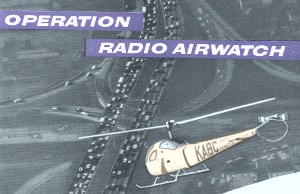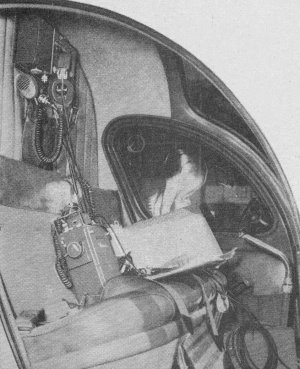July 1959 Popular Electronics
 Table
of Contents Table
of Contents
Wax nostalgic about and learn from the history of early electronics. See articles
from
Popular Electronics,
published October 1954 - April 1985. All copyrights are hereby acknowledged.
|
Wow, a $50,000 helicopter!
You can't touch a new heli these days for less than a third of a million dollars
(like a
Robinson R22). 1959 marked the early days of helicopter traffic
reports, I'm guessing before the really good noise cancellation headsets were available,
so drivers down in the traffic snarl tuned in their AM radios and got a lot of reporters
yelling into the microphone to overcome the rotor chop-chop-chop sound in the background.
According to this 1959 Popular Electronics magazine article, an airborne
GE unit of the era transmitted 3 watts at 26.19 mc (MHz), and received on a triple
conversion, crystal-controlled receiver. If you look at the one photo, you'll see
a Handie-Talkie on the passenger seat.
Operation Radio Airwatch
 By
Morris Moses By
Morris Moses
Radio-equipped helicopter spots Los Angeles Freeway traffic snarls
Chock-full of electronic and radio communication equipment, a colorful helicopter
prowls above the traffic-congested freeway system in Los Angeles, California. The
roving whirlybird seems to be everywhere at once, knows in an instant when safety
is threatened below, and shares this knowledge with some three million harassed
drivers faster than you can say, "turn off at the nearest intersection."
On call six days a week, 24 hours a day if need be, the trim $50,000 Bell 47-H
flies pilot Max Schumacher and newscaster Donn Reed 500 to 2500 feet above the jammed
freeway system. Hovering at a standstill, or cruising at 80 miles per hour, the
"Operation Airwatch" team transmits reports on traffic conditions to Radio Station
KABC which re-transmits these messages on its regular assigned frequency, 790 kc.
The driving public keeps its auto radios tuned to KABC for the latest traffic information.

The cockpit of the radio-equipped helicopter. Control box can
be seen mounted between two portable receivers. The standby "Handie-Talkie" is kept
on the seat.

Pilot Max Schumacher and announcer Donn Reed on the job.
Once Max and Donn spotted a little girl innocently playing with a ball right in
the middle of whizzing traffic on the Los Angeles Harbor Freeway. Donn got on the
air in about two seconds, and blurted out a warning to the Harbor Freeway traffic.
Minutes later, police arrived and bundled the little girl off to their lost-and-found
department.
Ingenious Equipment. Engineers and technicians at KABC wanted
a minimum of controls and switches on the 'copter. Simplicity, economy, and reliability
were the technical watchwords. Even though most of the equipment is of commercial
origin, there is a feeling of radio ham ingenuity and even "homemade" simplicity
about the installation.
The link between the 'copter and Station KABC is a commercial General Electric
15-watt FM transmitter and receiver. Units are identical at both the fixed and mobile
stations, with the exception of power supplies. The base station is a.c.-powered
and the equipment on the 'copter is powered from its 24-volt d.c. supply. The receiver
is a G.E. superheterodyne using a triple-conversion circuit, with each converter
employing a separate crystal-controlled oscillator.
Air Rescues. Police radio calls are monitored with the aid of a converted RCA
transistorized broadcast receiver. In between routine traffic guidance, the busy
whirlybird has followed the police calls to some very unusual air-rescue adventures.
When three teenage boys and a rubber life raft were mixing it up with the Los
Angeles River, pilot Max swooped down on the youths and helped push them ashore
with a blast from the whirlybird's rotors. Meanwhile announcer Donn gave the radio
audience below a spray-by-spray description of the rescue.
Other aircraft and landing field towers are contacted with a Lear 108-128 mc.
transceiver mounted on the instrument panel. Pilot Max keeps an "ear" on this (as
well as on the police call channel), leaving newscaster Donn free to study developments
on the complex highway panorama stretching below. Chats with passing aircraft often
help the Airwatch crew learn about urgent traffic situations not immediately within
their vision.
DX'ing Missouri. Just in case the main equipment should fail,
a battery-operated, crystal-controlled Motorola transceiver is always kept ready
to go. This set puts out about 3 watts at 26.19 mc. and can hold out for about 40
hours of normal operation. The Motorola was the original set used by the Airwatch,
and by some freak of transmission is often picked up by Radio Station KFRU in Columbia,
Missouri. "We have a regular ritual here of listening to the Los Angeles Freeway
helicopter reports" wrote KFRU.
Once the G.E. equipment "konked out." On went "Mickey-Mouse" (pilot Max's name
for the Motorola transceiver), and just in time; a serious freeway collision had
occurred involving an immense truck-trailer and four cars. Traffic started backing
up for miles. Newscaster Donn recalls:
"Five minutes after I radioed alternate routes, the freeway was so clear of traffic
you could have fired a cannon ball down it and not hit a car."
Cruising at about 80 mph one afternoon on a routine freeway report "mission,"
the radio 'copter saw the first few wisps of suspicious-looking smoke. Where there's
that kind of smoke at that hour in Los Angeles, there's probably a fire. There was;
at a codeine factory. Airwatch reported to the KABC base at 3:50 P.M. The station
called the Fire Department. The fire was snuffed out at 4:15.
Following the Cars. On weekends the radio watchbird follows
seashore-bound motorists to California's jammed beaches. Motorists are given weather
reports, visibility estimates, water and air temperatures, and advice on parking
problems. At baseball games the 'copter is always welcome, since traffic is particularly
heavy.
How does the average driver feel about Operation Airwatch? Well, when Max and
Donn asked the drivers to turn on their lights one evening, the bumper-to-bumper
caravan responded whole-heartedly. Result: the whole freeway system was lit up like
a fantastic Christmas tree. And that's a lot of watts.
Posted November 23, 2022
(updated from original
post on 10/10/2011)
|









 By
Morris Moses
By
Morris Moses


